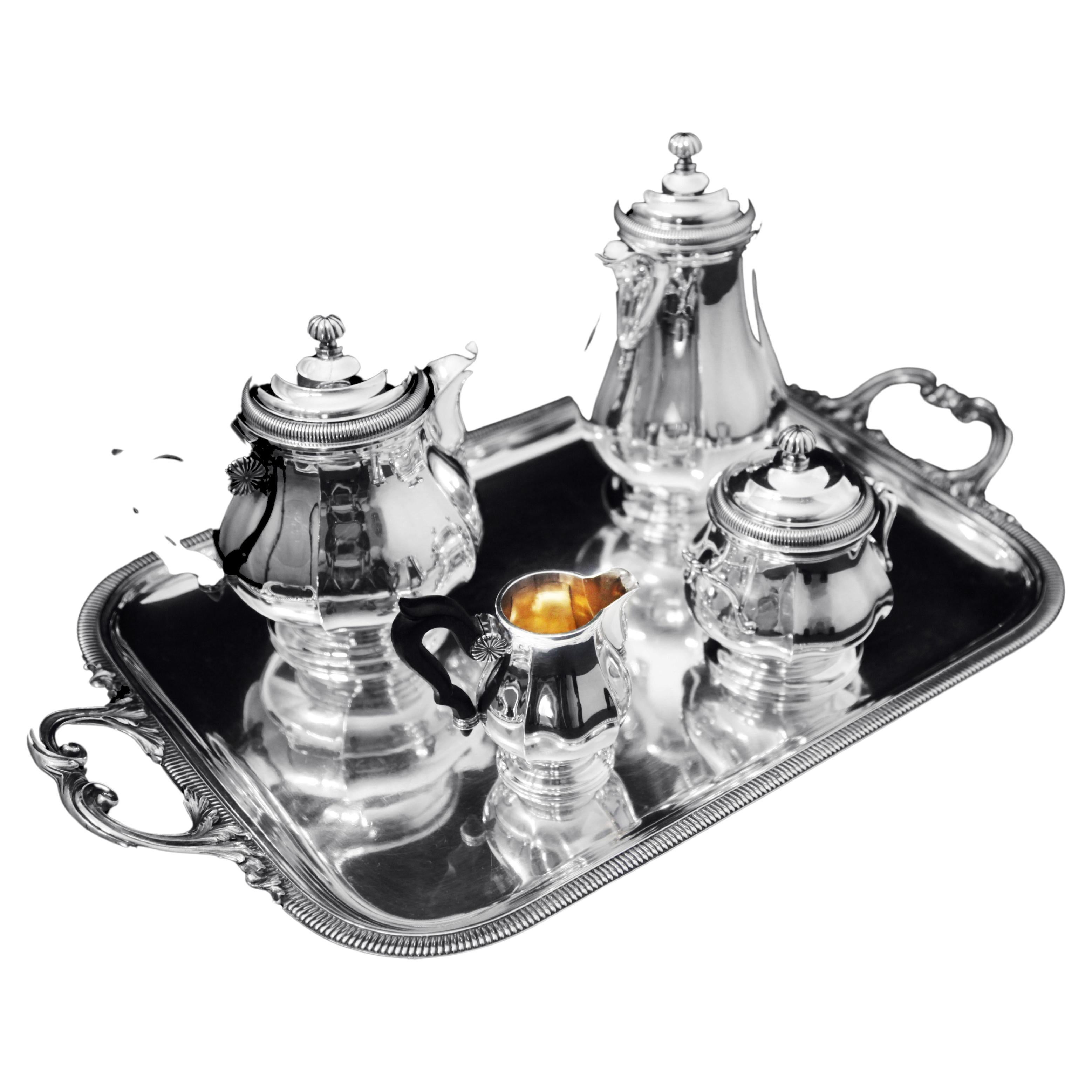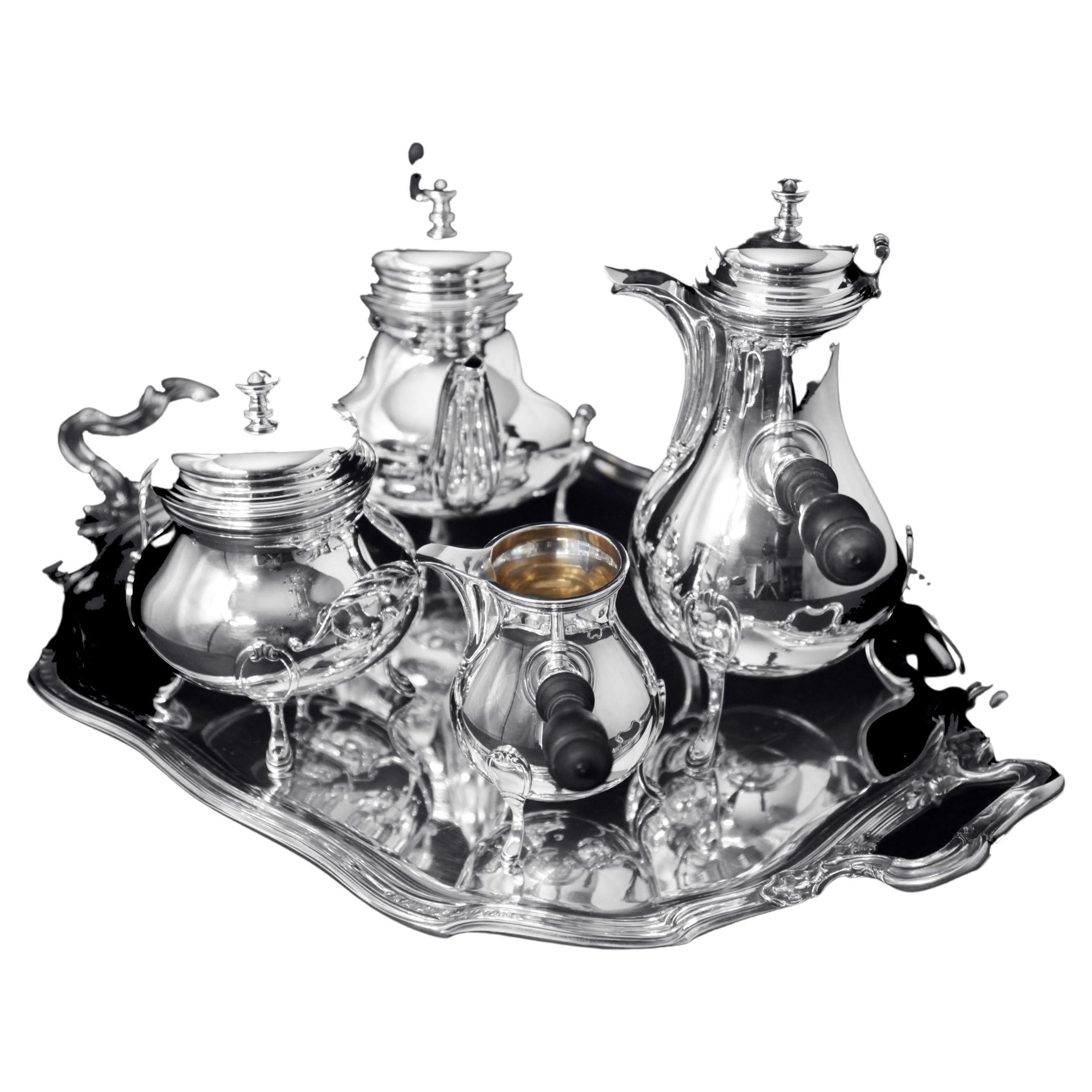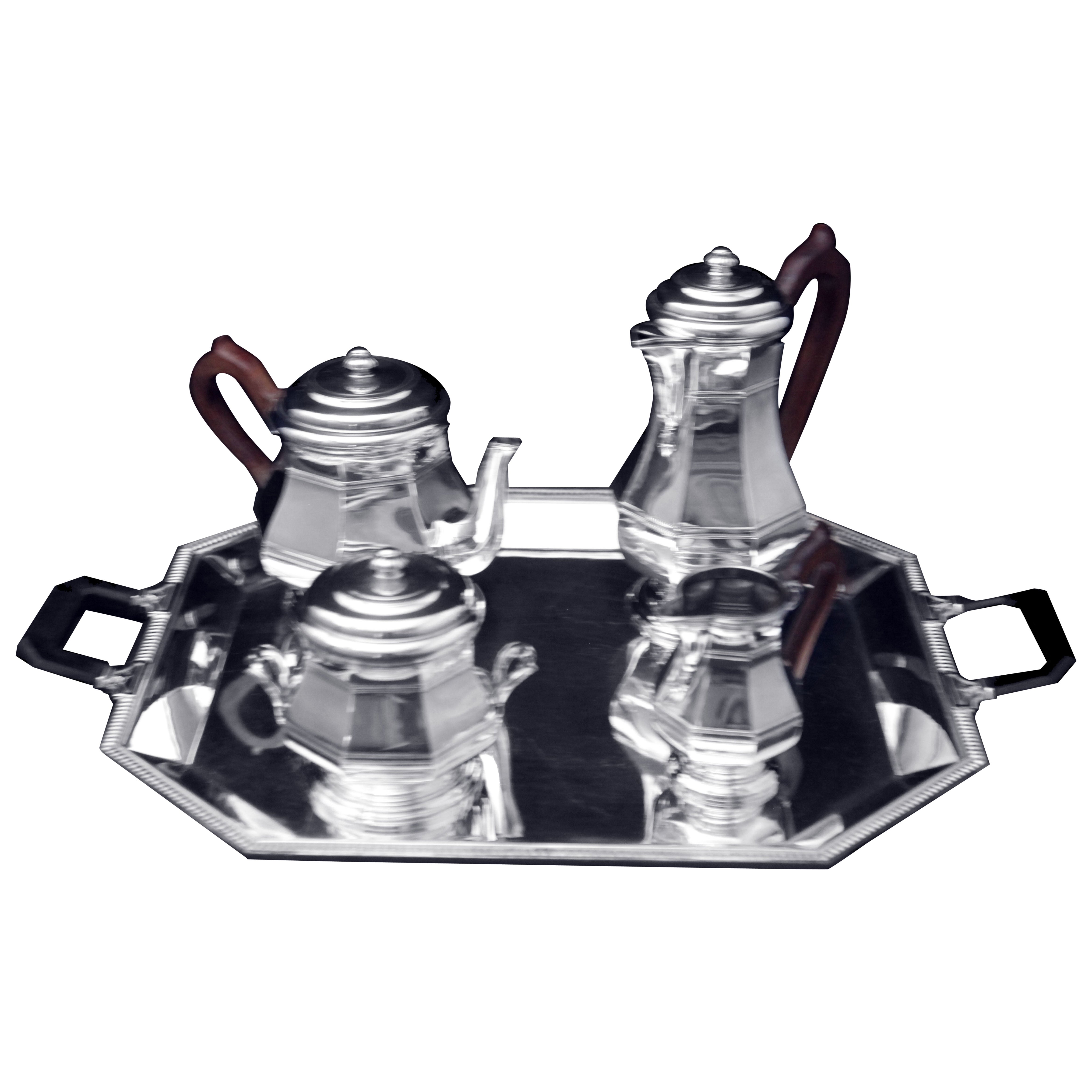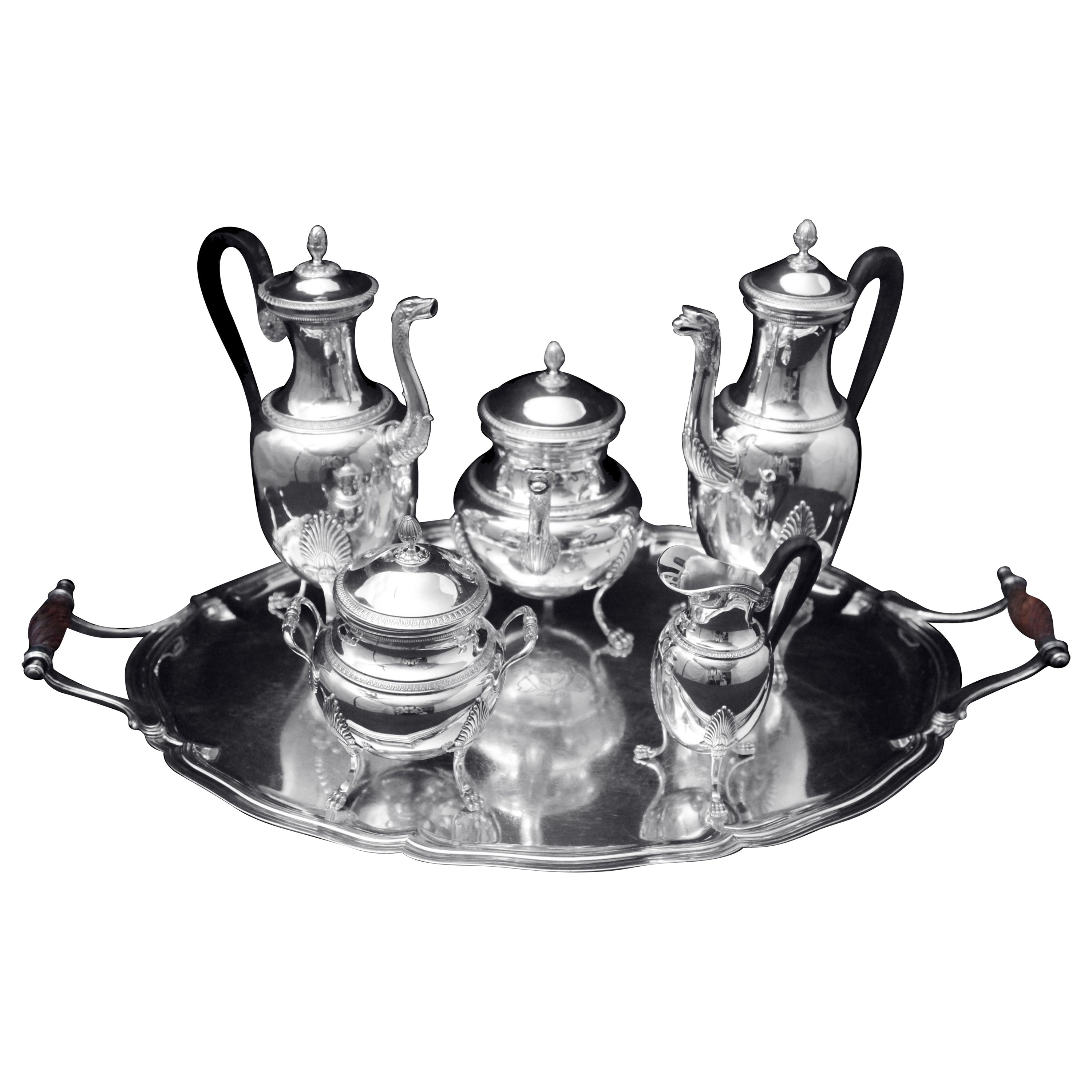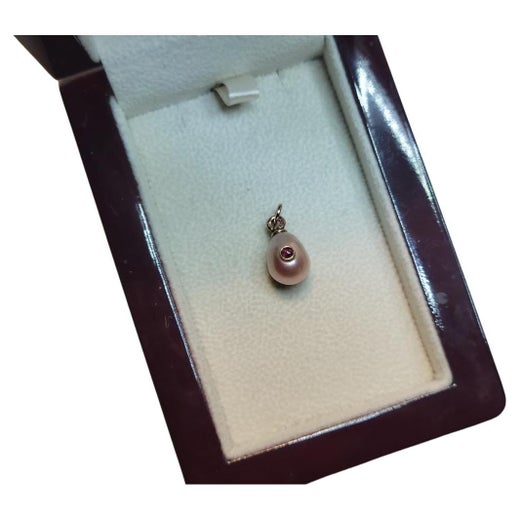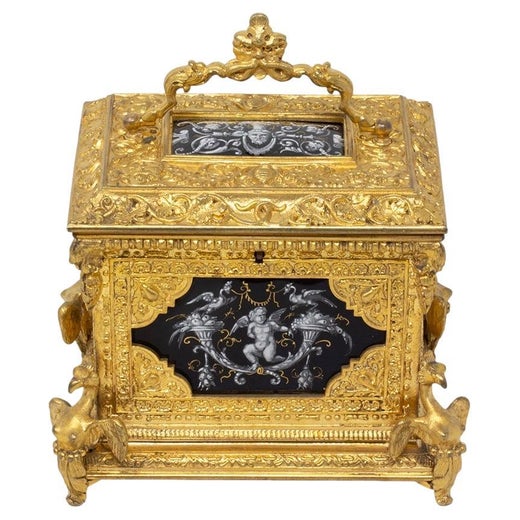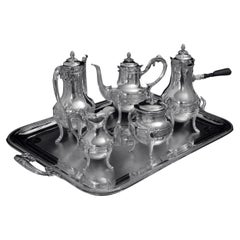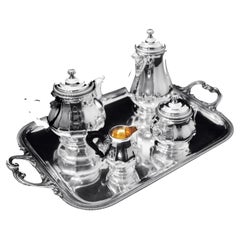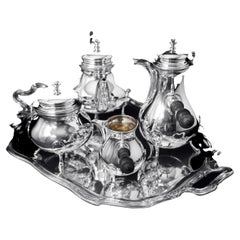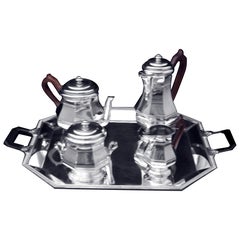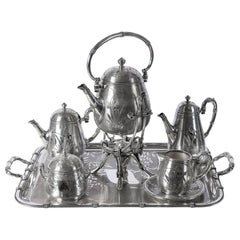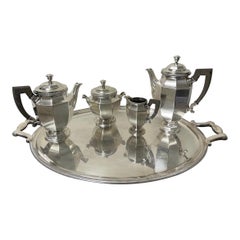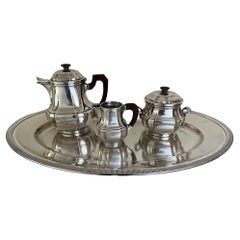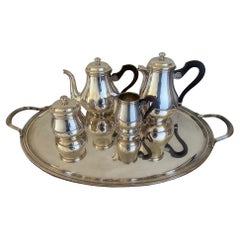Puiforcat (Hermes), Christofle, Faberge - 5pc. French 950 Sterling Tea Set
About the Item
- Creator:Fabergé (Designer),Puiforcat (Manufacturer),Limoges (Manufacturer),Christofle Cardeilhac 1 (Manufacturer)
- Sold As:Set of 14
- Style:Louis XV (In the Style Of)
- Materials and Techniques:
- Place of Origin:
- Period:
- Date of Manufacture:Circa 1890s
- Condition:Refinished. Each of the sterling silver pieces has been professionally restored to like new condition. The Limoges Faberge espresso cups and saucers are new.
- Seller Location:Wilmington, DE
- Reference Number:1stDibs: LU9583238243972
Fabergé
While the House of Fabergé is best known for creating the lavishly ornate and intricately devised Imperial Easter eggs given by the last czars to their families as annual holiday gifts, it was the most prestigious Russian luxury goods maker of the late 19th and early 20th centuries.
Serving the aristocracy and the well-to-do through stores in St. Petersburg, Moscow and as far afield as London, Fabergé crafted a wide range of brooches and other jewelry, clock cases, silver and myriad objets de vertu that included picture frames, cigarette cases, cufflinks and carved hardstone floral and animal figurines. Following the revolution, the firm was closed by the Soviet state in 1918.
Master goldsmith Gustav Fabergé, a descendant of Huguenot emigrées, founded the company in St. Petersburg in 1842. The firm did a brisk trade among the lesser nobility and the merchant class, but it flourished under the guidance of Gustav’s eldest son Peter Carl Fabergé — known also as Karl Gustavovich Fabergé — who took over in 1872.
Cosmopolitan, widely-traveled and himself a master goldsmith — he was sent on a Grand Tour in the 1860s — the younger Fabergé drew early design inspiration when he volunteered to catalogue and restore pieces in the imperial jewelry collection in the Hermitage.
Fabergé pieces based on historical jewelry from the Hermitage caught the attention of Czar Alexander III at a Moscow exhibition in 1882, and three years later he commissioned the first Imperial Easter egg as a gift for the czarina. Czar Nicholas II continued the tradition, presenting two eggs each Easter — one for his wife and one for his mother.
Relatively simple in design compared to the complex cloisonné-adorned eggs that followed, the first Fabergé egg was a white-enameled ovoid containing a gold “yolk” that held a gold hen, which in turn contained a replica of the imperial crown from which hung an egg-shaped ruby pendant.
As the appointed goldsmith to the royal court, the House of Fabergé became the darling of Russian aristocrats as well as wealthy patrons across Europe. Many and varied objets — hundreds of thousands by one count — were made to meet their demand. The firm employed some 500 craftsmen and designers when it was shuttered.
After the Russian Revolution, the Fabergé name and trademark endured a checkered passage through the 20th century.
Family members left their homeland in 1918 and set up a new business in Paris that was mainly concerned with repairing and restoring earlier-made wares. The name was adopted by an American fragrance and beauty products maker in the late 1930s, and later authorized by the family in a 1951 agreement. The trademark has been subsequently sold several times, and attached to numerous products including jewelry.
Fabergé pieces are richly redolent of a romantic past, and a source of thorough delight — for connoisseurs, true Fabergé refers to items made in the firm’s brief, golden decades from 1885 to 1917.
Collectors are advised to make a study of Fabergé works in museum collections such as the Victoria & Albert and the Royal Collection in London to gain an understanding of the quality of genuine goods made by the original firm, and then to purchase only from reputable and reliable dealers, such those at 1stDibs.
Find Fabergé eggs for sale and other objects and vintage jewelry on 1stDibs.
Limoges
Limoges porcelain has withstood the test of time for centuries. The widely cherished ceramics named for the French city and commune in which they are made are synonymous with sophistication, elegance and refinement. Today, antique Limoges dinnerware, serveware, decorative objects and other porcelain products are coveted and collected all over the world.
The story of Limoges porcelain, which refers to porcelain made in the Limoges region of France — not by a specific factory — begins in 1768. The region is a rich source of kaolin, feldspar and quartz — vital ingredients to the production of this type of pottery.
Porcelain was first made in China and spread all over the world owing to the trade routes to the Far East established by Dutch and Portuguese merchants. Given its origin, English speakers called porcelain “fine china,” an expression you still might hear today. "Fine" indeed — for over a thousand years, it has been a highly sought-after material. Meissen Porcelain (Staatliche Porzellan-Manufaktur Meissen), which was founded in the Electorate of Saxony (now Germany), is one of the preeminent porcelain factories in Europe and was the first to produce true porcelain outside of Asia.
Limoges porcelain refers to porcelain produced in and near the city of Limoges — it does not refer to a specific manufacturer — and it’s distinctive for its luminous hue and bright white qualities, providing an ideal canvas for intricately detailed hand-painted decorations. (Revered Impressionist painter Pierre-Auguste Renoir began his career painting plates in Limoges.)
It wasn’t long before Limoges porcelain captured the attention of King Louis XVI — the region’s first manufactory, established toward the close of the 18th century, was placed under the protection of the King’s brother, the Comte d’Artois. It was later purchased by the King and became Manufacture Royale de Limoges. The facility produced a variety of pieces, including delicate, gold-embellished trinket boxes, ornamental vessels, Rococo-style figurines and elaborate dinnerware service sets.
Following the end of the French Revolution in 1794, Limoges porcelain was no longer restricted, and the commercial porcelain industry ballooned.
By 1819, Limoges had four porcelain factories, and as demand for porcelain grew during the 19th century, the industry expanded in the French city. In 1853, American businessman David Haviland opened the Haviland & Co. factory in Limoges to export porcelain to the United States. The company produced several iconic serveware collections for many American presidents, including Abraham Lincoln, Ulysses S. Grant and Rutherford B. Hayes. Bernardaud opened in the early 1860s.
By 1900, Limoges had 35 factories, which employed close to 8,000 workers. In 1925, Limoges porcelain was shown at the International Exhibition of Modern Decorative and Industrial Arts — the design fair in Paris that brought global attention to the Art Deco style — where it garnered international acclaim.
During the 20th century, Limoges factories such as Bernardaud collaborated with a range of notable artists and designers, including Franz Bischoff, Joan Miró, Raymond Loewy, Alexander Calder and Julian Schnabel, to name a few.
Today, authentic Limoges porcelain tableware, vases and objets d’art continue to gain renown with collectors and design lovers all over the world.
Find an extensive collection of antique Limoges porcelain on 1stDibs.
- ShippingRetrieving quote...Shipping from: Paris, France
- Return Policy
More From This Seller
View AllAntique Late 19th Century French Louis XVI Sterling Silver
Silver Plate, Sterling Silver
Antique Late 19th Century French Louis XVI Tea Sets
Vermeil, Sterling Silver
Antique Late 19th Century French Louis XVI Tea Sets
Vermeil, Sterling Silver
Early 20th Century French Art Deco Tea Sets
Silver Plate, Sterling Silver
Early 20th Century French Empire Tea Sets
Sterling Silver
Early 20th Century French Louis XVI Tea Sets
Silver Plate
You May Also Like
Antique 1890s French Art Nouveau Tea Sets
Silver Plate
Vintage 1940s Sheffield and Silverplate
Silver Plate
Vintage 1930s French Art Deco Tea Sets
Silver Plate
Vintage 1980s French Empire Tea Sets
Silver Plate
Antique 1870s American Japonisme Tea Sets
Silver, Sterling Silver
Early 20th Century American Art Deco Sterling Silver
Sterling Silver
Read More
A Centuries-Old Style, Lockets Have Never Lost Their Romantic Appeal
Emblems of heartfelt emotion, elegant vessels for photos and keepsakes and perfect for layering, these special ornaments are an essential component of any thoughtfully curated jewelry collection.
Everything You’d Want to Know about Enamel Jewelry
From vibrant to subtle, elegant to cheeky, enamel jewelry encompasses a wide range of colors and styles, and there are almost as many techniques for creating these distinctive pieces.

